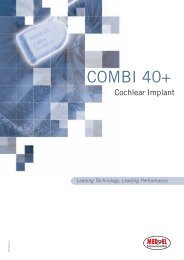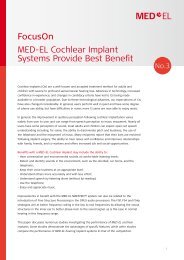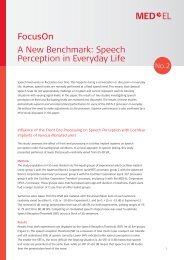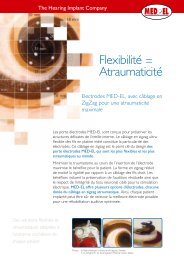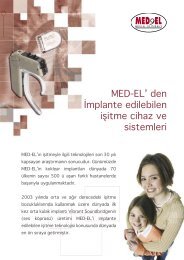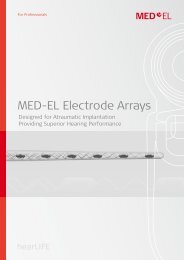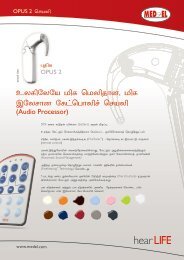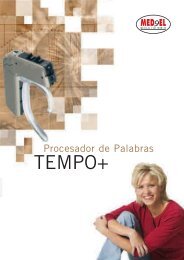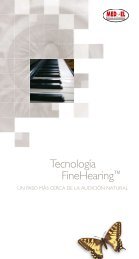You also want an ePaper? Increase the reach of your titles
YUMPU automatically turns print PDFs into web optimized ePapers that Google loves.
20<br />
12<br />
IS IT WORKING?<br />
A TROUBLESHOOTING PRIMER<br />
dAILY LISTENING CHECKS<br />
In order to feel confident that the system is working and the child is receiving<br />
the best sound possible, it is advisable to formally check the system every day. It<br />
is helpful to think about this from two viewpoints, the viewpoint of functioning<br />
equipment and also the viewpoint of good auditory discrimination. Obviously<br />
the child doesn’t hear properly if the equipment itself is not working. But it is<br />
also important to consider whether the child’s hearing is optimal throughout the<br />
day and from day to day as well.<br />
In order to establish a consistent and replicable method of evaluating the<br />
equipment and the child’s auditory discrimination, many parents, therapists, and<br />
educators do a routine daily listening check, preferably at the beginning of the<br />
day or session. This quick check should take no more than 1-2 minutes, and<br />
will help to establish your comfort zone about the function of the device and<br />
the child’s ability to make use of audition. In addition, some educators find it<br />
beneficial when working with very young children to repeat the listening check<br />
after PE or recess. The listening check should also be employed any time there is<br />
suspicion that the child is not responding in his or her typical fashion.<br />
Verifying auditory detection and discrimination<br />
Because we are checking for auditory ability, it is critical that the child has no<br />
access to visual cues during the daily listening check. Ideally, the child should be<br />
positioned next to and slightly in front of you (with the implant side nearest you)<br />
so that no speechreading cues are available. Another option for removing visual<br />
cues is to fashion a ‘listening screen’ from an embroidery hoop stretched with a<br />
lightweight but opaque fabric, such as 2 layers of stereo speaker cloth. do not<br />
use paper or cardboard, as the sound will be deflected, making the hearing task<br />
more difficult.<br />
Many professionals like to use a popular quick test called the “Six Sound Test”<br />
developed by the late daniel Ling. This quick stimulus/response test uses<br />
isolated speech sounds that cover the entire frequency spectrum of speech.<br />
The six sounds are:<br />
“mm” as in “mmm that’s good” (not “em” as in “the letter M”)<br />
“ah” as in “father”.<br />
“ee” as in “bee”<br />
“oo” as in “boot”<br />
“ss” (not ‘ess’)<br />
and “sh”<br />
The teacher should present each sound, one at a time, and expect the child<br />
to indicate that it was heard. Each sound should be presented using the same<br />
intonation and duration so the child can’t guess the sound based on those clues. For<br />
example, using a rising intonation for one sound and not others will cue the child,<br />
as will using a longer presentation of “mm”, “ss” or “sh” than for the vowels. The<br />
presentation order needs to be varied, and additional (unexpected) stimuli included<br />
from time to time, such as the child’s name or other familiar words, so that the task<br />
is not overly predictable.<br />
Responses will vary depending on the age, maturity and listening level of the child. In<br />
the very beginning, the response may be inconsistent and will need<br />
to be encouraged and taught. New implant users will not typically hear the<br />
difference between sounds – only that a sound was made. This is referred to<br />
as the ability to detect a sound. At this level, the listener is expected to indicate she<br />
has heard the stimulus by giving a simple response. The response can be anything<br />
you choose to teach: pointing to the ear, dropping a toy into a container, turning to<br />
look at you, vocalizing, etc.<br />
Soon we expect the child to move on to a higher level of auditory ability:<br />
discrimination. This means the child is beginning to recognize that sounds are<br />
different. For the purposes of these early tasks, we are expecting the child to detect<br />
and discriminate a set of phonemes, which are the individual sounds that make up<br />
the complex body of spoken language. during the discrimination phase, the child<br />
may begin to identify each phoneme as evidenced by her ability to repeat what<br />
is said to her. For example, the adult may say one of the six sounds (oo) and the<br />
child consistently repeats back, “oo.” This is an exciting development because it<br />
demonstrates that for this phoneme, the child is able to detect (hear the phoneme),<br />
discriminate (distinguish it from other phonemes) and identify (label it by virtue of<br />
repeating it).<br />
EQUIPMENT GUIdE: TEMPO+ and OPUS 1 SPEECH PROCESSORS<br />
21



